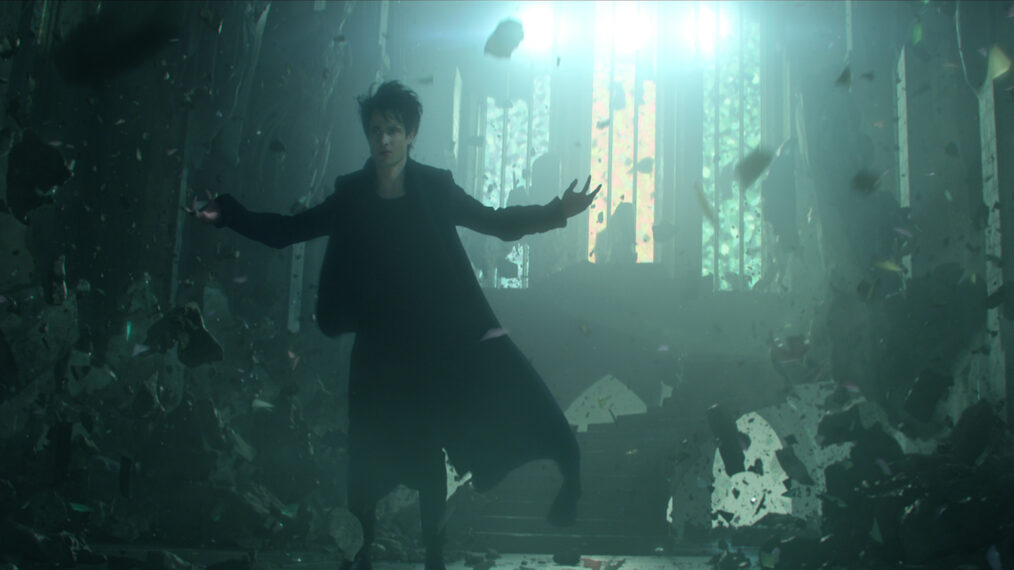On August 5, The Sandman dropped on Netflix. For Neil Gaiman’s existing fanbase, this show was the fulfillment of decades of longing to see a beloved story brought to life. Rumors have circulated over the years that Gaiman’s 75-issue comic series (variously collected in 10 graphic novels and the three-volume Absolute Sandman) would come to the screen, but such projects never materialized. In The Sandman, Netflix and Warner Bros. TV took the tools of contemporary storytelling and made a 2022 adaptation of a postmodern mythos. While the show clearly seeks to please a global fanbase, it holds the potential to open the story universe to a new audience and in so doing introduce it to a vivid image of the reality of natural law.
It is unclear how many seasons Netflix has planned, but the theme of change is elevated in this edition. In the comics, it took Gaiman several issues to find his voice and dominant theme; having found both, this retelling allows him to streamline the storytelling. Gaiman was once asked what the entire series is about: “The King of Dreams learns he must change, or die, and makes his choice.” That focus is present from the first episode. This adaptation also pays homage to the comics—many of the actors strongly resemble their comic originals in literal appearance or costuming, several scenes are directly modeled on the original artwork, and key lines translate from comic to Netflix seamlessly.
The Netflix edition takes the viewer through the first major movement of The Sandman story arc: We meet Dream as he is captured; learn of his place in the Endless; witness the results of imprisoning an “anthropomorphic principle” as sleeping disorders plague the world for a century; follow Dream as he recovers his tools and wreaks revenge on his captors; meet Cain, Abel, Lucienne (regendered as feminine in this edition–it works), Merv Pumpkinhead, and Matthew the Raven as Dream tracks down escaped nightmares and resolves the crisis of the Vortex, all while uncovering and evading the traps laid for him by Desire (an envious younger sibling).
While internet accusations of “woke Sandman” have run rampant, the Netflix version is no more radical than the original comics. Gaiman is no traditional conservative; his stories lean postmodern, often pushing the bounds of acceptability and denying the objectivity of truth. Most of his stories push past apparent reality into a deeper, more enchanted reality behind the material world. Such a setup enables Gaiman to press against cultural norms. The Sandman delights in featuring a host of once-unusual characters. Written across the 1980s and 1990s, The Sandman features an intersex character (Desire), a sympathetically portrayed transsexual (Gaiman’s word) named Wanda, and multiple gay relationships. While the Netflix adaptation hits viewers heavily with gay and lesbian characters, these characters are either in those relationships in the comics or heavily implied to be such. While there are many of these moments in the show (it earns the TV-MA rating), none of these relationships are shown in an unambiguously positive light. This kind of complexity, demonstrated through real characters, is Gaiman’s sweet spot as an author. He is comfortable dramatizing the complications that result from the interplay of desire, reason, and human action.
The Sandman has gone through at least three iterations in comic, audio, and now televised media. It continues to draw an audience for two primary reasons. First, the Endless comprise a postmodern pantheon for a post-Christian world. Instead of an all-powerful, benevolent deity, Gaiman constructs this universe around seven principles he calls “the Endless.” He explicitly states that they “are not gods.” They are instead personifications of forces, domains of life through which all humans move. Destiny wanders a path, tracing the way things must go. Though blind, he sees all. Death greets each person at beginning and end, escorting the soul to “the Sunless Lands.” Dream rules the realm where mortals spend “one third of their lives.” Dreams give rise to hope. Desire and Despair, twins, inspire the extremes of human action. Desire always pushes people to take what they want; Despair is the realm for those who have sunk below hope, symbolized by an obese woman who constantly cuts herself. Delirium (who used to be Delight) suffered some never-explained tragedy and is incredibly creative yet lives outside the laws of logic. The Endless have suffered their own loss: Destruction abandoned his post and remains absent. Pascal famously wrote of the “God-shaped hole” at the center of each human heart. Gaiman appeals to the universal longing for transcendence and builds a modern mythology around the human desire for deeper meaning in the world.
The second reason for the story’s popularity is that Gaiman’s Endless testify to the reality of natural law. The philosophical tradition highlights the natural law through reasonable exposition. Were I trying to teach students or convince an agnostic, I might turn to Aquinas, Kant, Aristotle, or perhaps C.S. Lewis to argue that the nature of each thing gives it a law, and that that thing’s flourishing depends upon fulfilling its nature. Gaiman goes a different route. He shows powerful beings who can shape the world yet are bound by their duties and responsibilities. This comes up most clearly in episode 6, “The Sound of Her Wings,” where Death reminds her little brother of the relationship between purpose and function. Dream has just won a major battle and recovered power he had stored in his tools. His victory feels hollow—vengeance did not satisfy. He explains to Death that he no longer knows what his purpose is. Death then takes him along on her work for the day: meeting mortals as they enter eternity. As Dream sees Death at work, he recovers “something he had forgotten,” that his “purpose is his function.” (It may be worth noting that for Gaiman, this principle applies generally to the task that defines each of the Endless but does not apply to the domain of sexual mores.) As ruler of dreams and nightmares, Dream’s task is to show humanity to itself in all its horrors and glories. That task is its own fulfillment.
At various points in the story, Dream is asked for favors. In the first episode, he narrates that humanity asks for “gifts which are neither theirs to take nor his to give.” Dream and his siblings, in the universe of The Sandman, are living expressions of the natural law. Limits exist that cannot be violated; tasks must be fulfilled lest flourishing vanish. The nature of the Endless binds them to their tasks, and through fulfilling their roles each increases the structural integrity of reality. We see this most clearly in the Rose Walker Vortex sequence (“The Doll’s House” through “Lost Hearts”). As a Vortex, Rose weakens the barriers between dreams. Left unchecked, borders between realms and minds will dissolve and reality will become a swirling maelstrom. Dream protects the borders: light and dark, waking and dreaming, material and spiritual.
Each iteration of The Sandman is contextualized. The comics reflect the edge of social progressivism in the 1990s: they accept homosexuality as a given, highlight feminism, and show sympathy for the transsexual. In the 2018 Audible adaptation, Gaiman illustrates his willingness to tweak some elements of the story; it has become less fashionable to insist that men and women are different from each other, and Gaiman minimizes gender distinctions. Debuting on Netflix, it is no surprise that the number of homosexual kisses in The Sandman is high. There is no suggestion in the comics that The Corinthian is gay, for example, but Netflix’s version often sleeps with his male victims before eating their eyes. This newest edition of Gaiman’s tale extends his radicalism while conveying an essential message of conservatism: Human flourishing depends upon limits, responsibilities, and restraining desire. Surely Gaiman would protest being called in any way “conservative,” yet he, too, preserves the old wisdom of mankind through his stories. Granted, The Sandman is an unexpected vehicle for an illustration of the natural law, but it conveys truths about reality through strong storytelling and beautiful filming. Here is an adaptation of a dark, gripping story about the cost of change within the human heart. It’s a story worth telling—and now, worth watching.

